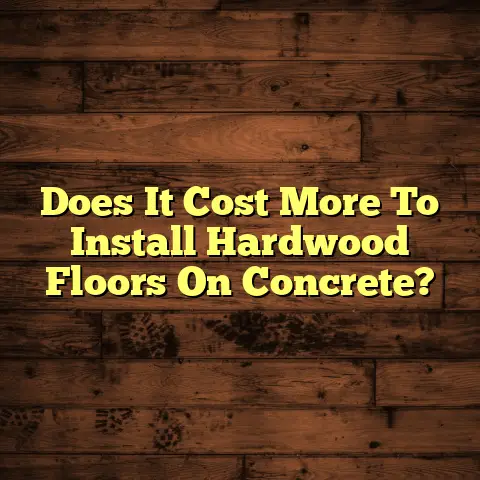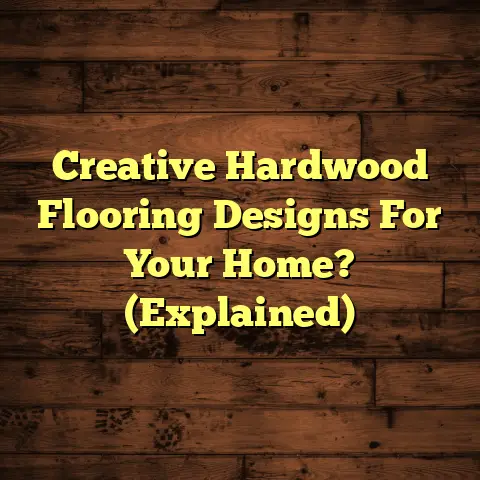Minimalist Flooring: Style or Flop? (3 Trends!)
As autumn leaves begin to paint the landscape in hues of red and gold, it’s a time when many homeowners turn their attention indoors. The shift in seasons often sparks a desire to create a warm, inviting, and clutter-free sanctuary. And what better place to start than with your flooring?
The allure of minimalist design during this time of year is undeniable. Its clean lines, simplicity, and calming aesthetic offer a welcome respite from the often chaotic and overwhelming nature of seasonal changes. But when it comes to flooring, the big question looms: Is minimalist flooring a lasting style choice, or just a fleeting trend destined to fade away like the summer sun?
I’ve been in the flooring business for over 15 years, and I’ve seen trends come and go. Today, I want to explore three specific minimalist flooring trends that are currently gaining traction to help you decide if they’re right for your home.
Trend 1: Natural Wood Finishes
Let’s dive into the world of natural wood finishes – a trend that’s been steadily gaining popularity in the minimalist flooring scene. What’s the big deal? Well, it’s all about bringing the warmth and organic beauty of nature indoors. As a flooring contractor, I can tell you that natural wood is a timeless choice that can transform any space.
The Allure of Natural Wood
Think about it: wood is inherently beautiful. Each plank tells a story through its unique grain patterns, knots, and color variations. This natural variation adds character and depth to a room, creating a sense of warmth and authenticity that’s hard to replicate with synthetic materials.
But not all wood is created equal. When it comes to minimalist design, the type of wood you choose matters. Let’s take a look at some popular options:
-
Oak: A classic choice known for its durability and versatility. Oak comes in a variety of colors, from light and airy white oak to rich and warm red oak. Its prominent grain pattern adds visual interest without being overwhelming.
-
Maple: A lighter-toned wood with a fine, subtle grain. Maple is a great option for creating a bright and airy minimalist space. It’s also incredibly durable, making it a practical choice for high-traffic areas.
-
Bamboo: A sustainable and eco-friendly option that’s gaining popularity. Bamboo is incredibly strong and durable, and it comes in a range of colors and styles. It’s a great choice for homeowners who are looking for a minimalist flooring option with a conscience.
As someone who’s worked with all these types of wood, I can attest to their individual beauty and durability. But choosing the right finish is just as important as choosing the right type of wood.
Finishes that Enhance the Minimalist Aesthetic
When it comes to minimalist design, less is often more. The same goes for wood finishes. Here are a few popular options that enhance the minimalist aesthetic:
-
Matte Finish: A matte finish is a great way to showcase the natural beauty of the wood without adding too much shine. It creates a soft, understated look that’s perfect for minimalist spaces.
-
Oiled Finish: An oiled finish penetrates the wood, enhancing its natural color and grain. It also provides a protective layer that helps to prevent scratches and stains.
-
Whitewashed Finish: A whitewashed finish is a great way to lighten up a room and create a bright and airy feel. It’s perfect for minimalist spaces that need a touch of freshness.
As a contractor, I’ve seen firsthand how the right finish can completely transform the look and feel of a room.
Adapting to Seasonal Decor Changes
One of the great things about natural wood flooring is its ability to adapt to seasonal decor changes. In the fall, you can add warm-toned rugs and throws to create a cozy and inviting space. In the spring, you can lighten things up with fresh flowers and pastel-colored accents.
Because of its timeless quality, natural wood resonates well with minimalist philosophy. It’s not a trendy material that will go out of style in a few years. It’s a classic choice that will last for generations.
Case Studies: Natural Wood in Minimalist Homes
Let’s take a look at some real-world examples of homes that have effectively incorporated natural wood finishes into their minimalist designs:
-
The Scandinavian-Inspired Home: This home features light oak flooring with a matte finish. The floors are paired with white walls and minimalist furniture to create a bright and airy space.
-
The Modern Farmhouse: This home features wide-plank maple flooring with an oiled finish. The floors are complemented by natural textures and earthy tones to create a warm and inviting space.
-
The Eco-Conscious Condo: This condo features bamboo flooring with a natural finish. The floors are paired with sustainable furniture and eco-friendly decor to create a stylish and sustainable space.
These are just a few examples of how natural wood finishes can be used to create beautiful and functional minimalist spaces.
Potential Drawbacks
Of course, no flooring option is perfect. There are a few potential drawbacks to consider when it comes to natural wood finishes:
-
Maintenance: Natural wood requires regular maintenance to keep it looking its best. This includes sweeping, vacuuming, and occasional refinishing.
-
Cost: Natural wood can be more expensive than other flooring options.
-
Susceptibility to Damage: Natural wood can be susceptible to scratches, dents, and water damage.
Here’s a table comparing the costs and maintenance needs of different wood types:
| Wood Type | Average Cost per Square Foot (Installed) | Maintenance Needs |
|---|---|---|
| Oak | $6 – $12 | Moderate |
| Maple | $7 – $14 | Moderate |
| Bamboo | $5 – $10 | Low |
Despite these potential drawbacks, I believe that the benefits of natural wood finishes far outweigh the drawbacks. With proper care and maintenance, natural wood flooring can last for decades and add value to your home.
Trend 2: Polished Concrete
Now, let’s shift gears and explore the trend of polished concrete flooring. This is a flooring option that’s been making waves in the minimalist design world, and for good reason. Its modern, industrial appeal and versatility make it a standout choice for homeowners who want to embrace a minimalist aesthetic.
The Modern Industrial Appeal
Polished concrete has a raw, unrefined beauty that’s hard to ignore. It’s a material that’s often associated with industrial spaces, but it can also be used to create a sleek and sophisticated look in residential settings.
The beauty of polished concrete lies in its simplicity. It’s a smooth, seamless surface that reflects light beautifully, creating a sense of openness and airiness. It also has a natural texture and variation that adds visual interest without being overwhelming.
Benefits of Polished Concrete
As a flooring contractor, I’ve worked with polished concrete on numerous projects, and I can attest to its many benefits:
-
Durability: Polished concrete is incredibly durable and can withstand heavy foot traffic.
-
Low Maintenance: Polished concrete is easy to clean and maintain. It doesn’t require waxing or polishing.
-
Versatility: Polished concrete can be stained, dyed, or textured to create a variety of looks.
-
Cost-Effective: While the initial investment can be higher than some other flooring options, polished concrete can be a cost-effective choice in the long run due to its durability and low maintenance needs.
Complementing Seasonal Decor
One of the great things about polished concrete is its ability to complement seasonal decor. In the winter, you can add warm rugs and throws to create a cozy and inviting space. In the summer, you can keep things cool and breezy with light-colored furniture and accessories.
Expert Opinions
I’m not the only one who’s a fan of polished concrete. I decided to reach out to a couple of my colleagues to get their opinion on the trend.
I spoke with Sarah Miller, an interior designer, who said, “Polished concrete is a great choice for minimalist spaces because it’s so versatile. It can be dressed up or down, depending on the decor. It’s also a great way to add a touch of industrial chic to any space.”
I also spoke with Tom Davis, an architect, who said, “Polished concrete is a sustainable and eco-friendly flooring option. It’s made from readily available materials and it doesn’t require any harsh chemicals to clean or maintain.”
Potential Challenges
Despite its many benefits, polished concrete does have some potential challenges:
-
Coldness: Polished concrete can feel cold underfoot, especially in the winter months. This can be mitigated by adding rugs or radiant floor heating.
-
Professional Installation: Polished concrete requires professional installation. It’s not a DIY project.
-
Cracking: Polished concrete can be susceptible to cracking if it’s not properly installed or maintained.
Here’s a quick look at the pros and cons of using polished concrete:
| Pros | Cons |
|---|---|
| Durable and long-lasting | Can feel cold underfoot |
| Low maintenance | Requires professional installation |
| Versatile design options | Susceptible to cracking if not maintained |
| Modern, industrial aesthetic | Initial cost can be higher |
Trend 3: Vinyl and Linoleum Innovations
Let’s talk about vinyl and linoleum. I know what you’re thinking: “Vinyl and linoleum? Really?” But trust me, these materials have come a long way in recent years. They’re no longer the cheap, outdated flooring options of the past. Today, vinyl and linoleum are making a comeback as stylish and sustainable choices for minimalist homes.
Resurgence of Vinyl and Linoleum
The resurgence of vinyl and linoleum is due to a number of factors, including:
-
Improved Aesthetics: Modern vinyl and linoleum are available in a wide range of designs, textures, and colors that mimic natural materials like wood, stone, and tile.
-
Enhanced Durability: Today’s vinyl and linoleum are more durable and resistant to scratches, dents, and water damage than ever before.
-
Sustainability: Linoleum is made from natural, renewable materials like linseed oil, wood flour, and cork dust. Vinyl is often made from recycled materials.
Fitting into Minimalist Design
Vinyl and linoleum can fit seamlessly into a minimalist design philosophy. They’re practical, affordable, and available in a variety of styles that complement minimalist aesthetics.
For example, you can choose vinyl or linoleum flooring that mimics the look of natural wood or stone. This allows you to achieve the look of these materials without the high cost or maintenance requirements.
Practicality in Seasonal Contexts
One of the great things about vinyl and linoleum is their practicality, especially in seasonal contexts. They’re easy to clean and maintain, making them a great choice for high-traffic areas like kitchens and bathrooms.
Here’s a table comparing the key features of vinyl and linoleum:
| Feature | Vinyl | Linoleum |
|---|---|---|
| Material | Synthetic (PVC) | Natural (Linseed oil, wood flour) |
| Water Resistance | Excellent | Good (if properly sealed) |
| Durability | High | High |
| Cost | Lower | Moderate |
| Sustainability | Varies (recycled options available) | High (made from renewable resources) |
Examples of Trendy Spaces
Here are a few examples of trendy spaces that are utilizing vinyl and linoleum effectively within minimalist design:
-
The Modern Kitchen: This kitchen features vinyl flooring that mimics the look of concrete. The floors are paired with white cabinets and stainless steel appliances to create a sleek and modern space.
-
The Minimalist Bathroom: This bathroom features linoleum flooring in a neutral color. The floors are paired with simple fixtures and clean lines to create a calming and spa-like atmosphere.
Criticisms and Misconceptions
I want to address some common criticisms and misconceptions about these materials in the context of minimalist style:
-
“Vinyl and linoleum are cheap and outdated.” While it’s true that older versions of these materials were not the most stylish, modern vinyl and linoleum are available in a wide range of designs and styles that can complement any minimalist aesthetic.
-
“Vinyl and linoleum are not sustainable.” While some vinyl products are made from virgin materials, there are also many vinyl options that are made from recycled materials. Linoleum is a naturally sustainable product.
Conclusion
So, we’ve explored three minimalist flooring trends: natural wood finishes, polished concrete, and vinyl/linoleum innovations. Each option offers a unique blend of style, practicality, and sustainability.
Is minimalist flooring a style trend that has staying power, or is it at risk of becoming a flop? Based on my experience, I believe that minimalist flooring is here to stay. The desire for clean, simple, and functional living spaces is not a fleeting trend. It’s a fundamental human need.
The future of minimalist flooring in home design is bright. As homeowners continue to embrace minimalist principles, we’ll see even more innovative and stylish flooring options emerge.
I encourage you to think critically about your flooring choices and the role of minimalism in your own living spaces. Consider your lifestyle, your budget, and your personal preferences. And don’t be afraid to experiment with different materials and styles to create a space that’s truly your own.





